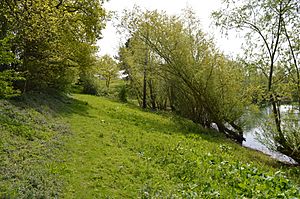Ardleigh Gravel Pit facts for kids
| Site of Special Scientific Interest | |
 |
|
| Area of Search | Essex |
|---|---|
| Grid reference | |
| Interest | Geological |
| Area | 1.2 hectares |
| Notification | 1992 |
| Location map | Magic Map |
Ardleigh Gravel Pit is a special place in Essex, England. It's a 1.2 hectare (about 3 acres) area south of Ardleigh. This site is important for geology, which is the study of Earth's rocks and history.
It's known as a Site of Special Scientific Interest (SSSI). This means the area is protected because it has unique natural features. In this case, it's important for understanding Earth's past.
Ardleigh Gravel Pit: A Window to the Ice Age
Ardleigh Gravel Pit shows us layers of Earth from the Pleistocene period. This time is often called the Ice Age. It was a period when huge sheets of ice covered much of the world.
At this site, you can see evidence of different times. There are layers from very cold, icy periods. Then, there are layers from warmer times in between. These warmer times are called interglacial periods.
What Makes This Site So Special?
One of the interglacial periods found here is very old. Scientists think it might be about 700,000 years old! This makes it a very important discovery.
The pit also holds tiny plant fossils. These are called microfossils. They are very rare and sometimes unique to Britain. They help scientists learn about the plants and climate from hundreds of thousands of years ago.
In 1992, experts from Natural England said this site was so special. They thought it could become a type site. This means it could be the main example for a new, previously unknown interglacial period in Britain. It helps us understand the Earth's climate history better.
Exploring the Site
Ardleigh Gravel Pit is split into two main parts. The biggest part is shaped like the letter 'L'. It forms the sloped edges of a pit that is now filled with water.
There's a public footpath that runs along one side of this main area. It goes between Slough Lane and Park Farm. This path lets you see some of the site.
The second part of the site is smaller. It's a long, narrow area that has been filled in. This smaller section is on private land. This means people cannot visit it without special permission.

